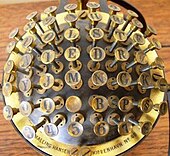This meant that no one in the days of typewriters could send the briefest business letter without first writing it down by hand, or else saying it into a recording device, or else dictating it to a shorthand-trained secretary.
After that it would be given to a typist, who would invariably read or mishear epiglottic for erotic and then the whole page - the whole page! would have to be typed out again.
A typewriter, you see, doesn't have abackspace button.
But I have come to praise typewriters, not to bury them, and when I saw one for sale the other day in a second-hand shop I was strongly tempted to buy it. Yes, typewriters were heavy and noisy and very hard work. Yes, they'd only give you at most three smudgy and faint copies of your letter (and only then if you'd put the carbon paper in the right way). Yes, a single keystroke error took a couple of minutes to correct. Yes, they were horribly slow unless you were very skilled indeed. But...
Actually, my affection for typewriters may be entirely sentimental. They were dreadfully awkward machines, but they were much more legible (and in the right hands, quicker) than writing by hand. They also gave employment opportunities to many women in the early twentieth century who were too educated or refined to do heavy manual work.

Many designs of typewriter were invented in many countries before the first one was made commercially. The Hansen Writing Ball, above, invented in Denmark by Rev Malling-Hansen, was produced from 1870. The keyboard was arranged so that the most frequently used letters were conveniently placed, but it only typed capital letters.
The first typewriter to be commercially successful came along in 1878 and was invented by Americans Christopher Latham Sholes, Frank Haven Hall, Carlos Glidden and Samuel W Soule, in Milwaukee, Wisconsin. (Entertainingly, Sholes later decided he hated the thing and refused to have anything to do with it.) This was the first machine to be called a typewriter. It had a QWERTY keyboard, and the rest is history.

Despite everything, you know, I still feel rather sad that the rest is history.
Word To Use Today: typewriter. Well, it's obvious where this word came from, but it's quite interesting that to begin with the person who operated the machine was also called a typewriter.
An earlier version of the machine, invented by John J Pratt, had the much more thrilling name of pterotype.
It would have been nice if that name had been the one to survive, wouldn't it?
Pteron in Greek means wing or feather.
No comments:
Post a Comment
All comments are very welcome, but please make them suitable for The Word Den's family audience.